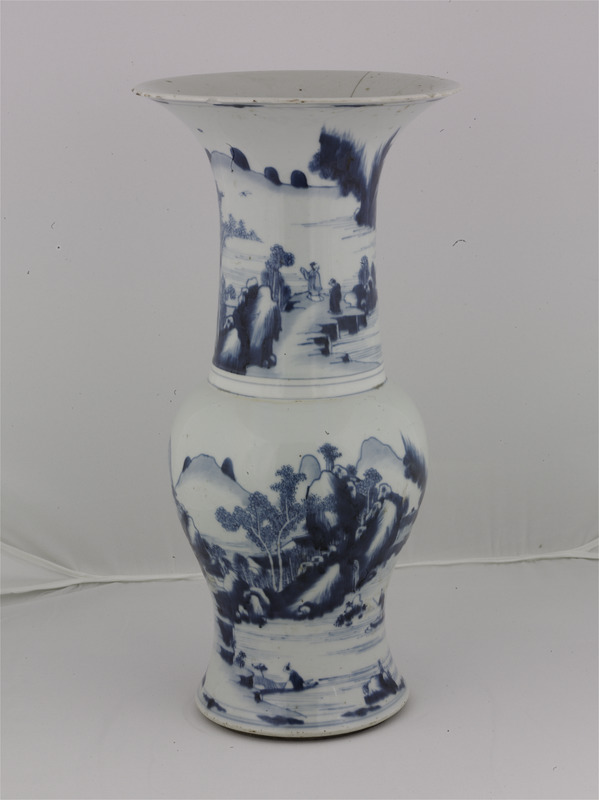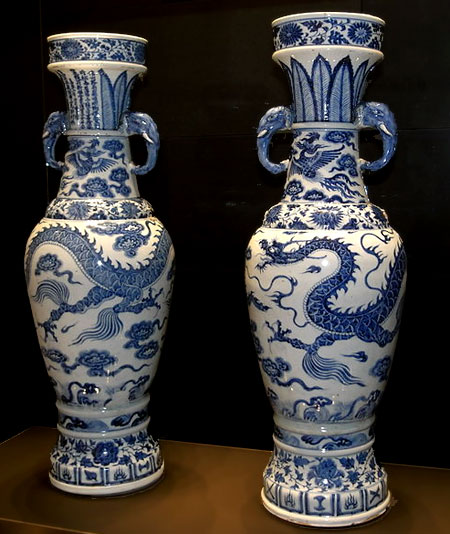Blue-and- white Phoenix-tail Shaped Zun

The Reign of Emperor Kangxi (1662-1722)
Height: 44.9cm; diameter at the mouth: 22.6cm; diameter at the bottom: 14.2cm
Transferred from the Hunan Provincial Antique Store in 1982
The Zun, with a beautiful shape, has a wide mouth and a narrow neck. The belly is wide and the bottom of the Zun stretches outward. Its bottom has both an inner cycle and an outer circle as the white glazed bottom is designed with two blue and white circles. The Zun gets its name from the fact that its mouth is much broader, just like the tail of the phoenix. The height of Zun ranges from 41cm to 46cm, with paintings on the body. Most of the Zun serve as ornaments or ritual containers. This Zun is a ritual container, as the bottom has the trace of yellow color which indicates that it has been fumed for a long time.
With the rigid structure and solid ceramic body, the phoenix-tailed Zun has the gray and blue color and its glaze is shiny and bright. The whole body of the Zun is decorated with blue and white glaze. Two panorama paintings of landscapes and figures are designed at the neck and body of the vessel respectively. They are divided by two circles. Though being independent, the two paintings are in great harmony as there are close-ups, the middle sceneries and the distant views. At the neck of the Zun, it is painted with one person, standing along the bank of the river, is asking another person questions in a polite manner. The answerer is pointing to his back and in the distance are the lofty mountains. At the middle view are slopes with some woods and there are cottages and pavilion nestled in the woods. At the close-up, the river runs and one person fishes alone. Similar scenes are depicted at the body of the Zun. However, the figures in the painting are doing the following things: the boatman steers the boat to shore; a passenger asks at the dock and the answerer points to his back; one person pilots the boat in the river, alone. This painting reflects such a theme: looking for the profound scholars, who lead the life of a recluse. This is just like two lines in a poem of Tang Dynasty, which go like this:
“Alone in the middle of this mountain,Deep clouds, not know where.”
The profound scholars are persons with lofty aims, profound knowledge, who prefer escaping from the official circles. They are wise men who live a reclusive life. Therefore, they are also called hermits. Scholar-bureaucrats always have such a complex of being a hermit. Common people admire the hermits as they are far away from the madding crowd. Such a culture influenced the design of the blue-and-white porcelains in China, as many paintings featuring the hermits living in the natural landscapes with mountains and rivers are designed on the porcelains.
深入探索
The interpretation of the inscription on the phoenix-tailed Zun
The inscription on the Zun reads: “A woman with the family name as Zhao, the wife of Li Maolin, believer of Buddhism at Dongxiang town, Anfu county, Ji’an city, solicits protection for her son from Buddha and hence donates this pair of porcelain vases to the Ancient Buddhist Temple on the Yaojin Mountain. She would always support the temple so as to pray for peace and happiness for her family. Date: September 1st, 1622 of the Chinese lunar calendar”. Therefore, this phoenix-tailed Zun is one of the two vases that a mother donated to the Ancient Buddhist Temple on the Yaojin Mountain so as to pray for peace for her son and her other family members. Only this one survives to this day.
The inscriptions written on the porcelain ritual containers follow a fixed format, including the following information: the address of the believer, the name, sacrificial object, the things that one prays for, the place of the worship and the time. Similar inscriptions can be found on the blue-and-white candlesticks of the reign of Tianqi Reign of Ming Dynasty and blue-and-white water bowl (ritual container) with the design of figures of the Reign of Shunzhi Emperor of Qing Dynasty collected by Shanghai Museum. These inscriptions fully demonstrate the unique features in the religious beliefs of the Chinese people: realistic, purposeful and utilitarian.

Blue-and-white elephant-eared vases with the design of the dragons of Yuan Dynasty, collected by the British Museum



